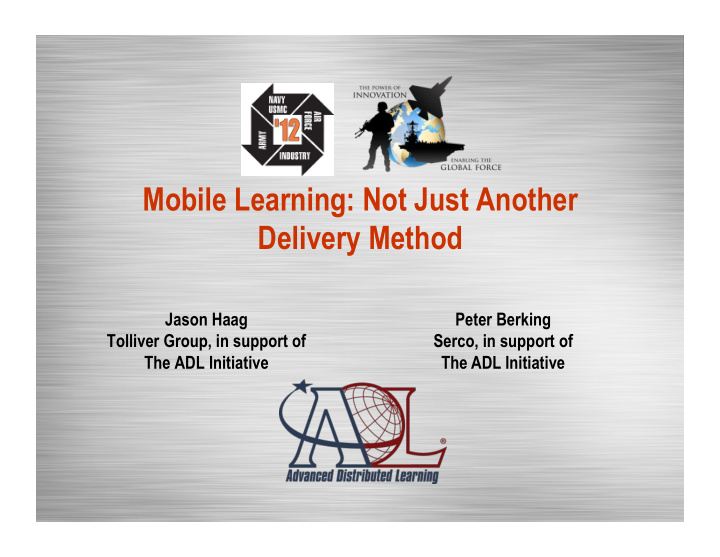



Mobile Learning: Not Just Another Delivery Method Jason Haag Peter Berking Tolliver Group, in support of Serco, in support of The ADL Initiative The ADL Initiative
What We’ll Cover � Mobile Learning: Not Just Another Delivery Method Background Mobile Learning Definitions ISD and ID Models Research Goals Literature Review Learning Theories & Instructional Strategies Proposed ADL Framework Lessons Learned & Future Research Work 2
Background • The Effectiveness of Mobile Course Delivery (Haag, I/ITSEC 2011) – Converted DoD-wide eLearning course to mobile format (Trafficking in Persons) – Limited to conversion only (no change to subject matter or instruction) – Conducted study of 70+ participants – 85% would like to complete mandatory training on mobile devices – 70% prefer mobile version to desktop – Led to new research questions regarding ISD and mobile learning (e.g. will ADDIE and ID models work? Do we need new ones?) 3
Mobile Learning Definitions Not Just Another Delivery Method Not Just eLearning Courses on Mobile Devices 4
Do You Define Mobile? Laptop Computer Jitterbug Smartphones Gaming Phones Netbook / Micro Laptop / Macbook Air eReaders Handheld Touch Screen Devices & Tablets 5
Definitions • Learner-focused or Device-focused 6
Mobile Learning = Ubiquitous Learning Learner- Device- focused focused 7
ADL Conception of Mobile Learning “Leveraging ubiquitous mobile technology for the adoption or augmentation of knowledge, behaviors, or skills through education, training, or performance support while the mobility of the learner may be independent of time, location, and space.” 8
The Mobile Paradigm Shift • What are the concepts, considerations, decisions, and guidelines specific to mobile learning? • Will traditional Instructional Design (ID) models work for mobile? • Should we prescribe a general “framework” instead and leverage existing models? • Instructional strategies for mobile learning strategies still require a needs analysis 9
ISD and ID Models 10
ADDIE • ADDIE is not a complex concept • All of the stages of ADDIE are logical; hard to ignore • ADDIE is only as good as the creativity, professional skill, and experience of the designers • Useful for planning; organizations won’t tolerate open-ended development • Flexibility is key! • New model applied by same team doesn’t necessarily equal better results 11
ID Models • An ID model is a systematic series of steps that helps the designer to determine learning needs, then conceptualize, choose strategies, and validate instructional approach • Usually not predicated on particular technology or strategy • Most steps not described at a very low level of detail (but more detailed than ADDIE) • Dick and Carey • ID models are agnostic of instructional strategies and delivery methods • ID models are planning tools for making decisions, taking appropriate actions • Performance support-optimized models • Rossett & Schafer (2009) • Gottfredson & Mosher (2011) 12
Research Goals • Determine which ID models and performance support strategies work for mobile learning content development • Measure the satisfaction and effectiveness of the different approaches • Identify the mobile-specific considerations in ISD • Provide guidance and best practices on mobile learning development for the DoD community
Literature Review • Most literature addresses rationales for mobile interface design, practical considerations, appropriate types of learning activities, and design best practices • Few attempts to identify how learning theories drive decision to use mobile learning and a particular mobile instructional strategy • Uden (2007) ID model based on Activity Theory • Cooper (2011) focused on learning style, instructional, and information processing preferences • Park (2001) presented categorization scheme based on Transactional Distance Theory • None address what steps to follow in designing mobile learning
Learning Theories and Instructional Strategies • Learning theories are invoked (explicitly or implicitly) in the ID process when the learning strategies need to be determined • Macro-strategies describe overarching elements: – Motivation and engagement – Information presentation – Practice and feedback – Assessment • Micro-strategies describe ‘what the learner does when’ • Learning theories rely on epistemology and cognitive science • Learning theories fall into 3 camps: – Behaviorist – Cognitivist – Constructivist • Important distinction between instruction vs performance support (though can be blended) 15
Learning Theories Learning Instruction Performance Support Constructivist Learning Behaviorist Learning Cognitivist Learning Objects/ Environments (CLEs) Objects/Programs Programs Extrinsically directed Intrinsically directed 16
Proposed ADL Framework • Allows for a instruction, performance support, or both • For instruction, puts learning theory in the driver’s seat • Allows existing ID models to determine approach • Also supports the need to support a mobile solution without revisiting due diligence (e.g. converting eLearning content) • Supports rapid-prototyping and agile methodology • Flexible approach to plug in mobile learning-centric principles and considerations • Uses ADDIE as a reference point (only because it is most universal model) • Learning macro-strategies and micro-strategies
18
Future Research Work Mobile Training Implementation Framework (MoTIF) • Refinement of the decision nodes within each of the ADDIE phases • Mobile-specific considerations and questions to ask • Document best practices on working with both existing and new content for mobile deployment • Army Fire Center of Excellence (FCoE) • JKO Joint Operational Access Concept (JOAC) • Stand-alone mobile component for ADL research project (Imaginarium) • Process that integrates appropriate ID models and approaches
Credits and References • Graphics: – http://www.defenseimagery.mil – http://www.schrockguide.net/bloomin-apps.html – http://k12onlineschools.org/production/Content/DesAndAssessPD /DesAndAssessPD.html • Books – Dick, W., Carey, L., & Carey, J.O. (2009). The Systematic Design of Instruction (7 th Edition). Pearson Education Publishers, Upper Saddle River, NJ. – Gottfredson, C., & Mosher, B. (2011). Innovative Performance Support. McGraw Hill Books, New York, NY – Rossett, A., & Schafer, L. (2007). Job Aids & Performance Support. Pfeiffer Publishing, San Francisco, CA. 20
Questions & Thank You! Jason Haag Peter Berking Mobile Learning Team ISD Team SETA Support Contractor SETA Support Contractor The Tolliver Group, Inc. Serco, Inc. jason.haag.ctr@adlnet.gov peter.berking.ctr@adlnet.gov 21
Recommend
More recommend